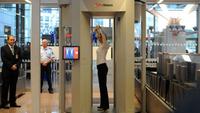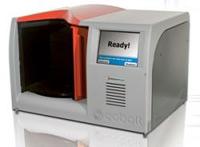-
Mass spectrometry for detection of trace quantities of explosives
The detection of trace quantities of explosives is critical to defending civilian populations from terrorist attacks; researchers have developed a method of modifying a commercial electrospray ionization source for ambient detection of explosives on surfaces
-
-
Detecting suicide bombers from a safe distance
Suicide bombings have now spread to Syria; a Florida company produces equipment designed to aid in the detection of a suicide bomber at standoff distances, before a terrorist can reach his intended target
-
-
Concerns raised about body-cavities explosives attack on aviation

Security services raised the possibility that al Qaeda affiliates may decide to mark the anniversary of the killing of Osama Bin Laden by sending suicide bombers with explosives inside their bodies to bring down airplanes; these experts point to an August 2009 attempt by a suicide body-bomber on a Saudi prince, and to the fact that U.S. drones earlier this year killed a Yemeni doctor who had devised medical procedures which could be used surgically to plant explosive devices in humans
-
-
Identifying ammunition, gun used to commit a crime
New, Raman spectroscopy-based gun-shot residue (GSR) analysis technique would make it possible for forensic investigators to match minute amounts of GSR to the exact type of ammunition, and the caliber of the gun, used to commit a crime
-
-
Test strip detects TNT and other explosives in water
Scientists developed a new explosives detector that can sense small amounts of TNT and other common explosives in liquids instantly with a sensitivity that rivals bomb-sniffing dogs, the current gold standard in protecting the public from terrorist bombs
-
-
DHS report concludes airport scanners are safe

A new report by the DHS Inspector General concludes that the Transportation Security Administration’s (TSA) full body scanners are safe; the IG reviewed five independent studies and concluded that an airline passenger would have to be subjected to 17,000 screenings a year, or forty-seven a day, to reach the limit of acceptable radiation dosing
-
-
Trinity University students help raise bomb sniffing dog
With the help of students at Trinity University in San Antonio, Texas, Jjurgens is being trained to fight against terrorism; Jjurgens, a four-month old yellow Labrador retriever, is the only dog in the United States being fostered at a university or school under the Transportation Security Administration Canine Breeding and Development Center program
-
-
Detecting explosives from a distance with laser beams
Scientists have found a way to detect chemicals over long distances, even if they are enclosed in containers; the scientists tested the system by trying to detect frequently used explosives, such as TNT, ANFO, or RDX from a distance – and the tests were successful
-
-
Rats trained to detect explosives
Bomb sniffing dogs could be a thing of the past thanks to explosives seeking rats; unlike dogs, when rats detect sensitive explosives like land mines they rarely set them off as they weigh less than pound
-
-
Advanced forensic tool for the battlefield
A forensic tool could soon make the analysis of evidence faster and more accurate, giving military investigators an advantage in the wars against drugs and terror
-
-
Reveal Imaging’s liquid explosive detector passes European test
Airline passengers could soon be allowed to carry liquids on board thanks to a new explosive detector by Reveal Imaging
-
-
55 dog teams to sniff out explosives at Olympics
At the upcoming London Olympic Games, more than 150 bomb-sniffing dogs will be on hand to detect any potential threats
-
-
NYPD developing concealed gun detecting tech
The New York Police Department (NYPD) is currently at work on a device that can detect if a person is carrying a concealed firearm from as far as eighty-two feet away
-
-
New scanner allows passengers to take liquids on board

A new bottle scanner enables aircraft passengers to carry liquid items larger than 100 ml once more; airports could now allow passengers to take items such as water, cosmetics, perfumes, and duty free through airport security channels from as early as 2013
-
-
Canada tests explosive detecting ticket readers
In a pilot program, Canadian light rail passengers in Edmonton will be scanned for explosives as they pass through ticket turnstiles in a seamless system that avoids recreating the long lines of airport security checkpoints
-
More headlines
The long view
Prototype Self-Service Screening System Unveiled
TSA and DHS S&T unveiled a prototype checkpoint technology, the self-service screening system, at Harry Reid International Airport (LAS) in Las Vegas, NV. The aim is to provide a near self-sufficient passenger screening process while enabling passengers to directly receive on-person alarm information and allow for the passenger self-resolution of those alarms.
